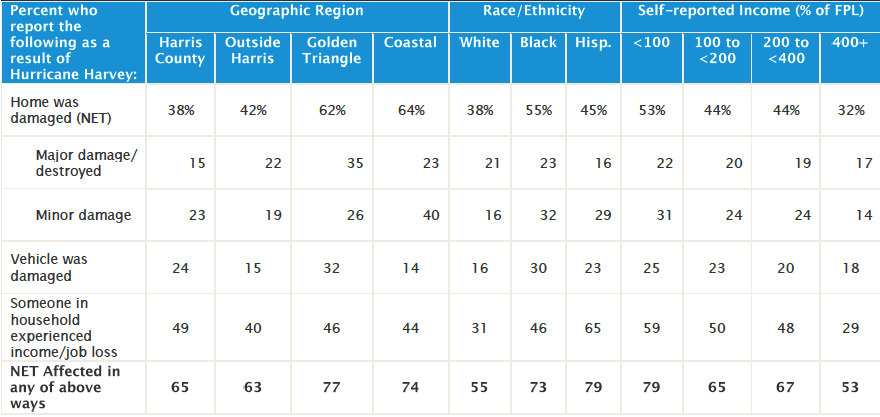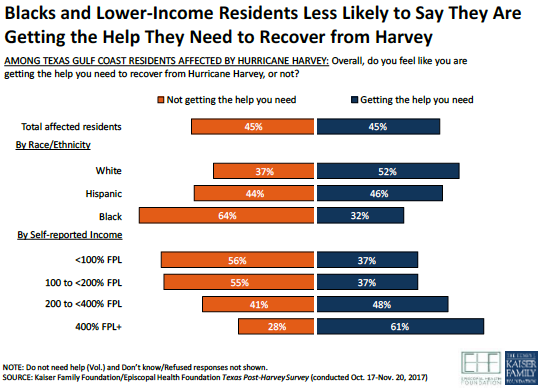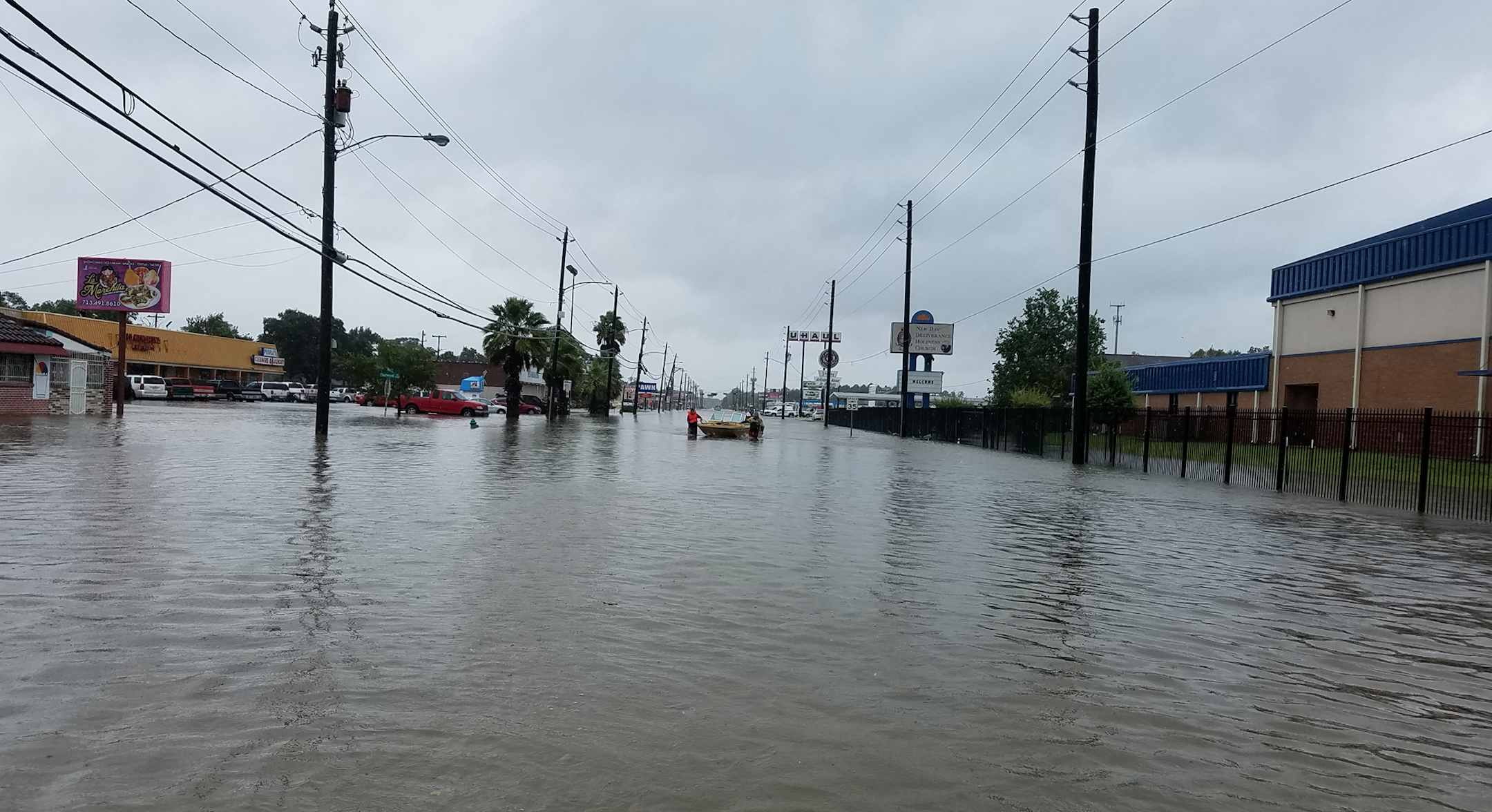Three months after Hurricane Harvey hit the Texas Gulf Coast, a new report shows that both its impact and the recovery from the unprecedented storm have been uneven across the region. The 24-county survey by the Episcopal Health Foundation and Kaiser Family Foundation documented that while 66 percent of residents said they suffered property damage or income loss as a result of the storm, roughly half of those affected aren’t getting the help they need.
Within just Harris County, the most populated county in the survey, 65 percent of residents said they were affected by the storm, with 38 percent saying their home sustained damage, 24 percent saying the same for their vehicle and 49 percent saying someone in their household had lost income or employment due to the storm.
“What people are experiencing and what they say they need and are concerned about is something that ought to be taken into account,” said Elena Marks, president and CEO of the Episcopal Health Foundation. “There is a tension between getting the dollars out the door quickly because there’s emergent and immediate need – and that’s appropriate – but there’s an inherent conflict with getting the money out quickly and using data for decision-making,” she said, adding that she hoped this report would prove useful for decision makers and help them better understand the uneven landscape of recovery thus far.
Indeed, much of Harvey’s impact was unequally distributed across race and income levels in the 24-county survey area. Black residents, for example, were more likely to have experienced home damage than white and Hispanic residents. Meanwhile Hispanic households were more likely to say someone in the household had lost income or had their hours cut at work than white or black households. And while a quarter of residents said their lives were “largely back to normal” and another 31 percent agreed their lives were “almost back to normal,” an additional 28 percent said their lives were “still somewhat disrupted” and 16 percent said their lives were “still very disrupted,” at the time of the survey, which was conducted between October 17 and November 20, 2017.

Source: Episcopal Health Foundation and Kaiser Family Foundation.
“The conventional wisdom that Texans hit by Hurricane Harvey have recovered is wrong,” said Drew Altman, president and CEO of the Kaiser Family Foundation, in a statement released with the report Tuesday. “The people in the hardest-hit areas are telling us that they still face major hurdles before their lives return to normal.”
In Harris County, the recovery appeared to be a little further along but 25 percent of respondents and 13 percent of respondents said their lives were still somewhat or very disrupted respectively. Most Harris County residents did not have to leave their homes during the storm. But 10 percent of Harris County residents who left their homes still had not returned at the time of the survey.
Across the affected counties, for those who said they still hadn't returned home, half said their housing costs had increased and 28 percent said their housing costs had increased a lot. And for those who had returned home, not all felt like they were living in safe conditions.
“I’m still scrubbing and it's moldy and it stinks,” one Houston woman said during one of the five focus groups supplementing the household survey. “I tell [my landlords] and they say, ‘You know we have other people, I'll get to you.’ They do the best they can here and there.”
Across the Gulf Coast region, nearly a quarter of residents said their vehicle was damaged in the storm and only roughly half of those residents had been able to replace or repair their cars by the time of the survey months after Harvey. For low-income respondents, only 38 percent had been able to replace or repair their damaged car.
The financial impacts of the storm appear to be wide-reaching but unevenly shared again. “Job and income effects were evenly distributed geographically for the most part,” reads the report, “but were much more commonly reported among Hispanic (65 percent) and Black residents (46 percent) compared with whites (31 percent), and among those with lower incomes compared to those with higher incomes.”

Note: FPL indicates federal poverty level.
Source: Episcopal Health Foundation and Kaiser Family Foundation.
With only 22 percent of affected residents across the 24-county region anticipating that insurance or other financial assistance will cover most of their losses, many families are facing a steep recovery. Roughly a third of affected residents said they have fallen behind on rent or mortgage payments. A quarter said they have had problems paying for food. And one in eight affected residents said they borrowed money from a payday lender following the storm.
“We’re still catching up with our bills,” said another Houston woman in a focus group. “We’re not at where we were at before.”
The report also highlights areas of need that are being overlooked or are likely to be overlooked, including the 15 percent of storm-affected Harris County residents – 17 percent across the 24 counties surveyed – who have a new or worsened health problem due to Harvey. And though Harris County was the most populous of the counties surveyed, the report drew attention to the larger percentages of people affected along the coast and in the hard-hit Golden Triangle area, covering Beaumont, Port Arthur and Orange. Recovering undocumented immigrants and their families also reported being worried about drawing attention to their legal status if they sought assistance.
Housing and financial assistance were among the top priorities of people surveyed, including not just rebuilding destroyed homes but also making more affordable housing available. Most of the affected respondents said they hadn’t applied for assistance. Only 44 percent reported applying for disaster assistance from either the Federal Emergency Management Agency or the Small Business Administration and most of them said their application was rejected or still pending. Only 26 percent of people who applied said they had been approved.

